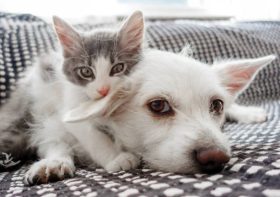The Value of Grooming and Care for Pets

Pets are our best friends, workout partners, superheroes, and stress relievers. When they are content and healthy, they can lead fulfilling lives and help us live extraordinary lives. As humans, we care daily for our appearance and personal hygiene. The same should apply to our four-legged companions.
Why is regular grooming so important?
Grooming and general pet care entail more than keeping your pet clean and attractive. It is also concerned with your pet’s physical health. You may wonder how this is possible, but brushing your pet’s fur helps remove dead hair, dirt, and dandruff. It also brings out the natural oils in their fur, giving it a lustrous, healthy sheen; these oils prevent tangles and mats, which can cause pain and infection.
Why is routine dental care essential?
Did you know that 80% of dogs and 70% of cats over three are affected by the dental disease? Dental disease is painful and unpleasant for pets, and the longer it goes untreated, the more difficult and costly it is to remove and clean their teeth. You can avoid plaque and dental disease by finding a good vet dentistry and giving your pet’s teeth the same care you do with your own.
Techniques for Dog and Cat Grooming
Grooming not only controls shedding but also keeps your four-legged friend comfortable and enables you to detect specific health issues before they become serious. Additionally, it is a great way to bond with your pet, or you can find a professional groomer if you don’t have the time. Listed below are specifics regarding various aspects of grooming:
Brushing
It’s important to brush and comb your pet’s coat daily or weekly, and finding the right one is crucial because brushes differ depending on your pet’s coat. Brush your pet before bathing it. In addition to removing dead hair and tangles, brushing distributes natural skin oils. If the coat is dense, brush the skin. If you apply excessive force when pulling nets, you will experience pain. Use a detangler to remove knots from dry hair.
Brushes have different coats. Long, straight coats require a curved wire slicker or a pin brush. Medium-length hair and dense undercoats require a more challenging wire. During the season of shedding, undercoats can be brushed with rakes. Use a rubber curry or a grooming mitt to brush short, sleek coats. Use an all-purpose comb to remove any remaining knots after brushing.
Dental Care
Brushing your pet’s teeth regularly can significantly reduce the risk of periodontal disease. When done with patience and kindness, most animals enjoy mouth massages. Having healthy teeth and fresh breath are among the benefits. Additionally, you will recognize when your pet requires professional dental care before they experience pain. Remember to use species-specific animal toothpaste. Click to learn more about dental care.
Nail Maintenance
Whether your pet prefers to relax indoors or outdoors will determine how often you should trim their nails. When the nails of indoor animals grow into the pads of their paws, they may need to be cut to prevent pain and infection.
Eye and Ear Care
Always maintain bright, clear, and moist eyes. Notify your vet of any redness, irritation, or cloudiness. Additionally, you should check your ears once per week. Turn the ears inside out, examine their interiors, and even sniff them. Consult your veterinarian if they are red, swollen, full of debris, or have an odor to prevent infection and disease.
Conclusion
Family pets are important family members. We recognize the advantages of routine pet grooming, but it can be time-consuming. It has been demonstrated that regular grooming and general pet care prevent disease, infection, and discomfort. Contact your veterinarian to learn more about an individualized health regimen for your pet.


